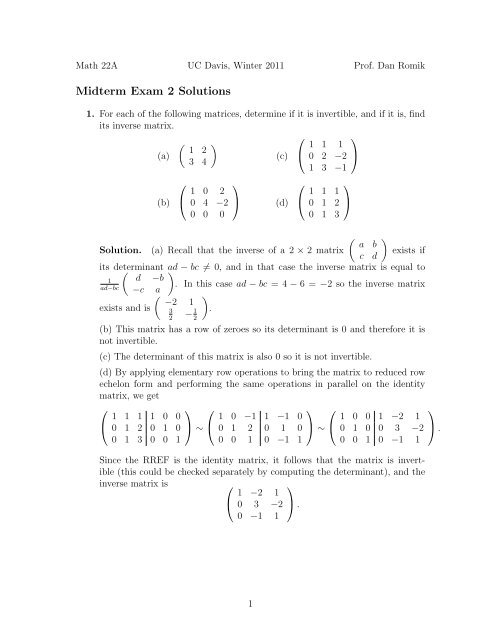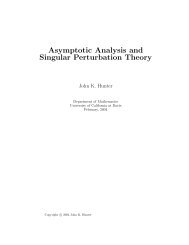Midterm Exam 2 Solutions
Midterm Exam 2 Solutions
Midterm Exam 2 Solutions
You also want an ePaper? Increase the reach of your titles
YUMPU automatically turns print PDFs into web optimized ePapers that Google loves.
Math 22A UC Davis, Winter 2011 Prof. Dan Romik<br />
<strong>Midterm</strong> <strong>Exam</strong> 2 <strong>Solutions</strong><br />
1. For each of the following matrices, determine if it is invertible, and if it is, find<br />
its inverse matrix.<br />
⎛ ⎞<br />
� �<br />
1 1 1<br />
1 2<br />
(a)<br />
(c) ⎝ 0 2 −2 ⎠<br />
3 4<br />
1 3 −1<br />
(b)<br />
⎛<br />
⎝<br />
1 0 2<br />
0 4 −2<br />
0 0 0<br />
⎞<br />
⎠ (d)<br />
⎛<br />
⎝<br />
1 1 1<br />
0 1 2<br />
0 1 3<br />
Solution.<br />
�<br />
a<br />
(a) Recall that the inverse of a 2 × 2 matrix<br />
c<br />
�<br />
b<br />
exists if<br />
d<br />
its determinant � �ad<br />
− bc �= 0, and in that case the inverse matrix is equal to<br />
1 d −b<br />
. In this case ad − bc = 4 − 6 = −2 so the inverse matrix<br />
ad−bc −c<br />
�<br />
a<br />
�<br />
−2 1<br />
exists and is<br />
.<br />
3<br />
2<br />
1 − 2<br />
(b) This matrix has a row of zeroes so its determinant is 0 and therefore it is<br />
not invertible.<br />
(c) The determinant of this matrix is also 0 so it is not invertible.<br />
(d) By applying elementary row operations to bring the matrix to reduced row<br />
echelon form and performing the same operations in parallel on the identity<br />
matrix, we get<br />
⎛<br />
⎝<br />
1 1 1 1 0 0<br />
0 1 2 0 1 0<br />
0 1 3 0 0 1<br />
⎞<br />
⎛<br />
⎠ ∼ ⎝<br />
1 0 −1 1 −1 0<br />
0 1 2 0 1 0<br />
0 0 1 0 −1 1<br />
⎞<br />
⎛<br />
⎠ ∼ ⎝<br />
⎞<br />
⎠<br />
1 0 0 1 −2 1<br />
0 1 0 0 3 −2<br />
0 0 1 0 −1 1<br />
Since the RREF is the identity matrix, it follows that the matrix is invertible<br />
(this could be checked separately by computing the determinant), and the<br />
inverse matrix is ⎛<br />
1 −2 1<br />
⎞<br />
⎝ 0 3 −2 ⎠ .<br />
0 −1 1<br />
1<br />
⎞<br />
⎠ .
2. Write the 6 different permutations of 1, 2, 3. For each permutation, find its sign<br />
and its inverse permutation.<br />
Solution.<br />
3. Define the matrices<br />
⎛<br />
M =<br />
⎜<br />
⎝<br />
�<br />
Permutation<br />
�<br />
sign<br />
�<br />
inverse<br />
1 2 3<br />
1 2 3<br />
+1<br />
1 2 3<br />
1 2 3<br />
� 1 2 3<br />
2 1 3<br />
� 1 2 3<br />
1 3 2<br />
� 1 2 3<br />
2 3 1<br />
� 1 2 3<br />
3 1 2<br />
� 1 2 3<br />
3 2 1<br />
0 1 0 0<br />
3 −2 2 1<br />
0 15 0 1<br />
5 5 5 5<br />
�<br />
�<br />
�<br />
�<br />
�<br />
⎞<br />
-1<br />
-1<br />
+1<br />
+1<br />
-1<br />
� 1 2 3<br />
2 1 3<br />
� 1 2 3<br />
1 3 2<br />
� 1 2 3<br />
3 1 2<br />
� 1 2 3<br />
2 3 1<br />
� 3 2 1<br />
3 2 1<br />
⎛<br />
�<br />
�<br />
�<br />
�<br />
�<br />
�<br />
⎟<br />
⎠ ,<br />
3<br />
⎜<br />
N = ⎜ 0<br />
⎝ 0<br />
9<br />
1<br />
0<br />
−1<br />
0<br />
2<br />
−1<br />
16<br />
3<br />
0 0 0 2<br />
Compute the determinants: det(M), det(N), det(MN), det(M −1 ), det(adj(M)).<br />
Hint: Recall that the adjoint matrix adj(M) satisfies M · adj(M) = det(M)I.<br />
Solution.<br />
⎛<br />
det(M) = (−1) det ⎝<br />
3 2 1<br />
0 0 1<br />
5 5 5<br />
⎞<br />
⎠ = (−1)(−1) det<br />
� 3 2<br />
5 5<br />
⎞<br />
⎟<br />
⎠ .<br />
�<br />
= 5,<br />
det(N) = 3 × 1 × 2 × 2 = 12 (an upper triangular matrix),<br />
det(MN) = det(M) det(N) = 5 × 12 = 60,<br />
det(M −1 1 1<br />
) = = 5 det(M) ,<br />
�<br />
det(adj(M)) = det (det(M))M −1<br />
�<br />
= det � 5M −1� = 5 4 det � M −1� = 5 3 = 125.<br />
2
Note: when multiplying an n × n matrix by a scalar c, the determinant gets<br />
multiplied by c a total of n times (one for each row), so the new determinant is<br />
c n times the original determinant:<br />
det(cM) = c n det(M)<br />
4. Let L : R2 → R2 � � be a linear transformation given by L(v) = Av, where A =<br />
−15 −30<br />
. Find the two eigenvalues λ1, λ2 of A and for each eigenvector<br />
10 20<br />
find an associated eigenvector.<br />
Solution.<br />
�<br />
λ + 15<br />
det(λI − A) = det<br />
−10<br />
30<br />
λ − 20 c<br />
�<br />
= λ2 − 5λ = λ(λ − 5).<br />
This is 0 iff λ = 0 or 5. Thus λ1 = 0, λ2 = 5 are the two eigenvalues. Solving<br />
the equations<br />
(λ1I − A)v1 =<br />
� 0<br />
0<br />
�<br />
�<br />
0<br />
, (λ2I − A)v2 =<br />
0<br />
in the usual way leads to the corresponding eigenvectors<br />
v1 =<br />
� −2<br />
1<br />
�<br />
, v1 =<br />
� −3<br />
2<br />
5. Let M be a 5 × 5 matrix. Let N be the matrix obtained by reversing the order<br />
of the rows of M.<br />
(a) Are M and N row-equivalent? If so, describe a sequence of elementary<br />
row operations that transforms M into N.<br />
Solution. Yes, they are row-equivalent. The operations are: swap rows<br />
1 and 5; swap rows 2 and 4.<br />
(b) Find a matrix A such that N = AM.<br />
Solution. We can express the row operations as multiplication from the<br />
left by the corresponding elementary matrices: N = ER1↔R5ER2↔R4M.<br />
Therefore the matrix A is<br />
�<br />
.<br />
ER1↔R5ER2↔R4 = ER1↔R5ER2↔R4I<br />
which is the matrix obtained from I by performing the same operations.<br />
That is,<br />
⎛<br />
0<br />
⎜ 0<br />
A = ⎜ 0<br />
⎝ 0<br />
0<br />
0<br />
0<br />
1<br />
0<br />
0<br />
1<br />
0<br />
0<br />
1<br />
0<br />
0<br />
⎞<br />
1<br />
0 ⎟<br />
0 ⎟<br />
0 ⎠<br />
1 0 0 0 0<br />
3<br />
�
(c) If det(M) = 3, find det(N).<br />
Solution.<br />
det(N) = det(AM) = det(A) det(M) = det(ER1↔R5) det(ER2↔R4) det(M)<br />
= (−1) × (−1) × 3 = 3<br />
4

















